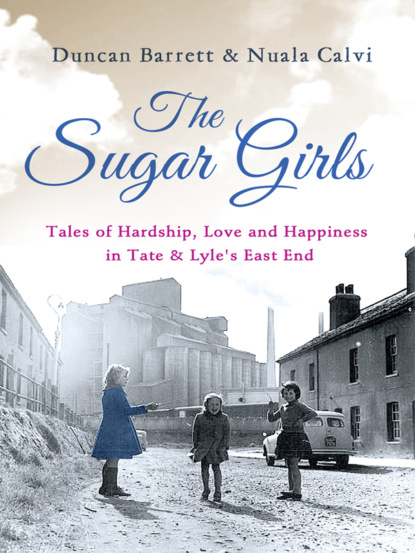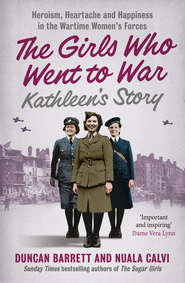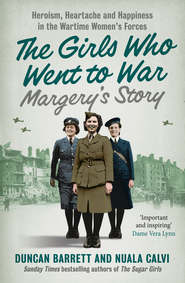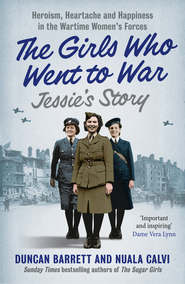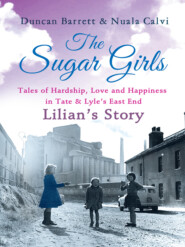По всем вопросам обращайтесь на: info@litportal.ru
(©) 2003-2024.
✖
The Sugar Girls: Tales of Hardship, Love and Happiness in Tate & Lyle’s East End
Настройки чтения
Размер шрифта
Высота строк
Поля
The families were scrupulous in keeping up professional boundaries – although the senior Tates and Lyles took the same train from Fenchurch Street Station every morning, they made sure to sit in separate carriages, and never acknowledged each other.
By the end of the First World War it was clear that the competition was actually hurting both companies, but neither had a clear upper hand: the Lyles had the edge in profitability, but the Tates’ output was not to be rivalled. A merger was the obvious way forward. Negotiations began, and for three years Ernest Tate and Charles Lyle tore their hair out in frustration as proposal after proposal was rejected by their respective boards. A deal was finally agreed in 1921.
The new Tate & Lyle company retained both London factories – Tate’s Thames Refinery in the heart of Silvertown and Lyle’s Plaistow Wharf Refinery a mile upriver. The management of the two factories, however, remained in the hands of the respective families. The original Tate and Lyle, Henry and Abram, were both long dead by now, and had never known the fate of their companies. In fact, they had never even met.
The old rivalry didn’t die out completely, though, and from 1937 onwards it was played out in a more friendly fashion, on the company’s new shared sports ground. There, the workers from ‘Tates-es’ and ‘Lyles-es’ (as the two factories continued to be known by the locals) would compete against each other in football and cricket.
The Second World War brought great changes to both refineries, as their workforces became female-dominated for the first time. As men were called up, the management were forced to blur the strict distinctions between ‘men’s’ and ‘women’s’ jobs, with female workers tackling even the most physically demanding and high-status roles, including that of the panmen who boiled up the sugar liquor. The women were thrilled to see their wages go up when they took on such new jobs, but they were still only paid 75 per cent of what their male counterparts had earned.
After the war the men reclaimed their old roles, but a shift had taken place and the crucial part that the sugar girls played in the company’s success could no longer be ignored. In 1948 a mixed-sex canteen was built at the Plaistow Wharf Refinery, and for the first time the women were able to eat alongside their male colleagues.
Today, after the closure of the docks and almost all of the local factories, much of Silvertown has the feeling of a ghost town. It is overshadowed by the planes taking off and landing at City Airport – whose runway cuts between the Royal Albert and King George V docks – and the looming concrete viaducts of the Docklands Light Railway. Many of the old Victorian terraces have been replaced by blocks of council flats, and the pubs, shops and cafés that once lined the North Woolwich Road opposite the Plaistow Wharf Refinery are all gone. The close-knit neighbourhoods, and the way of life that once thrived there, have vanished and can never be recovered.
Tate & Lyle is unusual in having retained its Silvertown factories, although from the late 1960s much of the Plaistow Wharf Refinery was demolished as its sugar refining activities were wound down. Many loyal workers took redundancy rather than accept a transfer downriver to the Thames Refinery. Even there, the company now employs only a small fraction of its former workforce, and the jobs once done by the sugar girls are all performed by machines.
Tate & Lyle has long since stopped being a family firm, and in 2010 it was bought by an American sugar giant. However, the legacy of its original founders lives on. In 2006 the iconic Lyle’s Golden Syrup tins were officially recognised by the Guinness Book of Records as the oldest brand in Britain. Meanwhile, the philanthropic work of the Tate family is remembered in the libraries and art galleries that bear its name.
But the contribution of those ordinary young women who played such a central role during Tate & Lyle’s East End heyday is not widely recognised, and their lives have not generally been recorded.
This is the story of those women, the teenagers who left school and gave the best years of their lives to Tate & Lyle. This is the story of the sugar girls.
1
Ethel
On a crisp September day in 1944, Ethel Alleyne stood outside Tate & Lyle’s Plaistow Wharf refinery, looking up at the giant gate with its elaborate wrought iron and shining white clock.
A wiry, frizzy-haired girl with light-brown skin and keen dark eyes, she was wearing her best dress for the occasion – black with red trimmings. In one hand she clutched her headmaster’s testimonial, already proudly committed to memory:
Ethel’s attendance has been regular and punctual. She is a very willing, cheerful girl, always ready to give her best. Her neatness and tidiness and general attention to detail are very pleasing. I can recommend her to any employer as a conscientious worker.
At 14, Ethel had never been inside a factory, but she felt as if she’d been preparing for this moment all her life. She had grown up in the heart of Silvertown and was used to living in the shadow of the Sugar Mile – the stretch of colossal factories that ran between Tate & Lyle’s sugar and syrup refineries. The factory life was in her blood – her mother’s family had lived in the area for generations, working in Keiller’s jam and marmalade factory, and her grandfather would tell anyone who would listen that he remembered when Silvertown was little more than a marsh.
From a hut on the left of the entrance emerged a fierce-looking man in the smart, military-style uniform of a commissionaire, his navy-blue tunic buttoned up to the collar and the silver buttons gleaming in the sunlight.
‘Yes, darlin’?’
Ethel drew herself up to her full height and did her best to hide her nerves. ‘I’m here about a job,’ she told him.
‘In here.’ He gestured for her to follow him into the little hut.
Inside, Ethel stood anxiously while a man in a white boiler-suit glanced over her testimonial and noted down a few details on a form. ‘Hesser Floor, I reckon,’ he told her briskly, ‘but the surgery will need to check you out first. I’ll get a girl to take you.’
Before long a smartly dressed young woman who looked to be in her late teens arrived at the door. ‘Hesser girl?’ she asked Ethel, as they stepped out of the hut.
‘Um, I think so,’ Ethel replied, ‘but I’m not sure what that means.’
‘Oh, Hesser of Stuttgart make the sugar-packing machines, but we try to keep that quiet these days! Come on.’
The two girls headed into the refinery.
Ethel was quite unprepared for the sight that met her eyes. She knew that the factory was big, but seeing it up close, from the inside, was another matter. Ahead of her, slightly to the right, the enormous grey-brick hulk of the Hesser building towered over her. At its base a team of boys and burly-looking girls were standing on a raised level open to the yard, loading up great haulage lorries with tonne-weight boards of sugar bags. To her left, another large building housed the factory’s bar and Recreation Room, and in front of her wagon tracks crisscrossed all over the ground, branching off straight ahead towards the syrup shed, where the Lyle’s Golden Syrup tins were filled. Underneath it was the Blue Room, where the sugar bags were printed, and beyond was the can-making department, where girls produced the famous tins. In the distance she could make out the looming white concrete of the pan house, where sugar liquor was boiled into crystals, and next to it an even taller set of chimneys from the boiler house.
Ethel searched in vain for the shining curve of the Thames, where the boats of raw sugar were unloaded. She knew it must be at the far end of the site, but through the jungle of warehouses in between she couldn’t catch a glimpse of the water.
As the two girls hurried across the yard, a musty, malty smell of damp sugar hit them in a cloying wave – shortly followed by another, ranker odour that almost made Ethel retch. She knew what it was, but tried her best not to think about it: the pile of rotting carcasses just the other side of the factory wall, at John Knight’s soap works. It was a smell that every Tate & Lyle worker had to learn to ignore.
In the surgery, a young nurse listened to Ethel’s heart, took her blood pressure and checked the movement and strength of her limbs. Then she carefully scoured her frizzy hair for nits, before passing her fit for service.
Ethel followed the other girl back towards the dark-grey Hesser building, on the outside of which a black metal staircase zigzagged up all eight floors. ‘It’s a long way up but you get used to it,’ said the girl, as they began to climb the steps.
As they neared the top, Ethel was beginning to lose her breath, so she was relieved to spot a sign that read: SMALL PACKETS. They went into a cloakroom, where Ethel deposited her coat and bag, and then through a pair of double doors onto the factory floor.
The noise as they stepped through the doors was overwhelming. The large room echoed with the rattle and grind of a dozen machines, huge lumps of iron around which stood teams of young women. Over the top of the noise there was music blaring out, and some of the girls were singing along.
They went up some stairs to an office on a mezzanine level, and as the door clicked shut behind them Ethel was aware of a blissful quiet settling around her. The girl left her in front of an impeccably tidy desk on which stood a little sign: IVY BATCHELOR, FORELADY. Behind the desk sat a tall, upright woman in a long white coat. Her brown hair had evidently been expertly styled, and her nails and make-up were immaculate.
‘Take a seat,’ she said calmly, gesturing to a chair on the other side of the desk.
Ethel did so, sitting up as straight as she could. She was determined to make a good impression.
The forelady looked at her kindly, reached for a form from a pile on her desk and took down Ethel’s name and address. ‘Is there any particular reason you want to work at Tate & Lyle?’ she asked.
Ethel hesitated. She had dreamed of working at one of the giant sugar factories ever since she was little and her dad had taken her to the Tate Institute, the social club opposite the Thames Refinery. They had gone to see a show laid on for local residents and employees, and Ethel had been transfixed – not merely by the dancers onstage, but by the glamorous young women who thronged the hall watching them. They were the factory’s female workforce and her dad had told her they were known as the sugar girls.
She felt self-conscious at the idea of telling that story, though. ‘I only live down the road,’ she offered instead.
Ivy Batchelor laughed gently. ‘Now, I’m afraid we can’t offer you a uniform at present, unless you have ration coupons to spare, but we should be able to lend you an apron for the day.’ She rummaged around under the desk and came up with a rather worn-looking pinny. ‘Your hours are eight to four Monday to Friday and eight to twelve on Saturday. You’re allowed half an hour for dinner and two toilet breaks a day. Any questions?’
Ethel shook her head.
‘Good. Then Mary will see you to one of the machines.’
As if on cue, a stern-looking woman with dark hair marched through the door of the office and gestured for Ethel to follow her. She was Mary Doherty, one of the department’s three supervisors, known as charge-hands.
‘This way,’ she commanded. Ethel jumped up and followed her onto the floor.
At each machine, paper bags were moving along a conveyor belt and being filled with sugar from a chute overhead. They were then sealed with a spurt of glue and a girl took them off the belt, piling them up ready to be packed. A packer then pulled down a sheet of brown paper and flipped the bags onto it in layers until they had made up a parcel, sealing it like an envelope with a bit of cold water and heaving it onto a board. When a tonne-weight of sugar had been assembled, it was taken away on a trolley down to the lorry bay. In charge of each machine was a driver, who paced around keeping an eye on everything. The girls’ various repetitive movements combined to give the impression of an elaborate ballet.
Mary led Ethel across to a machine at the far side of the room, where a woman with giant hands was parcelling up the sugar bags.
‘This is Annie Stout,’ Mary told Ethel. ‘She’ll show you how the packing is done.’ She strode off across the floor and back up to the office.
Ethel noticed that on the ends of Annie’s fat fingers were ten little paper thimbles. ‘You’ll need some of these,’ she told her, ‘or your hands’ll be bleeding by lunchtime.’
Without once interrupting her flow, Annie instructed Ethel in how to make her own thimbles from some spare scraps of paper. Then she stood back and let her have a go at packing.
At first Ethel found it hard holding several bags at once in her hands, but if she applied enough pressure to the sides, and lifted them in a clear, fluid arc, twisting them rapidly before they had a chance to slip, she found that she could manage it without dropping any.





